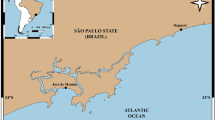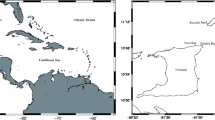Abstract
Settlement into the benthic habitat may be an important process in regulating sea urchin abundance, which potentially modifies the structure of benthic communities. Strong settlement events may increase sea urchin abundance beyond a certain threshold, leading to the formation of coralline barrens (overgrazed communities with a dominance of encrusting coralline algae). To understand the role of settlement in regulating sea urchin populations we first need to determine settlement variability. Temporal variation in settlement of the sea urchin Paracentrotus lividus was monitored at three sites in the Medes Islands, NW Mediterranean, during three settlement seasons (March 1998 through October 2000). Spatial variation in settlement was studied in 1999 at 50 sites along a gradient of exposures to waves and currents, inside and outside the archipelago, and separated by distances from tens to thousands of meters. Bathymetric distribution of settlement was also studied in 2000 at six sites at 5, 10, 15 and 20 m depths. Settlement of P. lividus occurred in a single annual peak within 3 weeks in May–June. Differences in settlement between years were more than two orders of magnitude. Spatial variability was found at all scales investigated, showing strong patchiness at the smallest spatial scales (tens of meters). Sea urchins settled preferentially at depths between 5 and 10 m. Substratum type, level of protection, and adult population densities were not significant in determining settlement. However, settlement was found to be related to the degree of exposure to waves and currents, indicating that physical processes are very important at the spatial scales investigated. This greatly variable settlement is a necessary, although not sufficient, condition to create gradients of adult P. lividus abundance. Further studies should be designed to investigate the interaction between settlement strength and post-settlement mortality.







Similar content being viewed by others
References
Andrew NL (1993) Spatial heterogeneity, sea urchin grazing, and habitat structure on reefs in temperate Australia. Ecology 74:292–302
Bak RP (1985) Recruitment patterns and mass mortality in the sea urchin Diadema antillarum. In: Gabrié C, et al (eds) Proc 5th Int Coral Reef Congr, vol 5. Antenne Museum–EPHE, Moorea, French Polynesia, pp 267–272
Balch T, Scheibling RE (2000) Temporal and spatial variability in settlement and recruitment of echinoderms in kelp beds and barrens in Nova Scotia. Mar Ecol Prog Ser 205:139–154
Balch T, Hatcher BG, Scheibling RE (1999) A major settlement event associated with minor metereologic and oceanographic fluctuations. Can J Zool 77:1657–1662
Ballesteros E (1989) Estructura y dinámica de la comunidad infralitoral de Codium vermilara (Olivi) Della Chiaje de la Costa Brava (Mediterráneo occidental). An Biol 15:191–208
Cameron RA, Schroeter SC (1980) Sea urchin recruitment: effect of substrate selection on juvenile distribution. Mar Ecol Prog Ser 2:243–247
Chelazzi G, Serra G, Bucciarelli G (1997) Zonal recovery after experimental displacement into two sea urchins co-occurring in the Mediterranean. Mar Ecol Prog Ser 212:1–7
Connell JH (1985) The consequences of variation in initial settlement vs. post-settlement mortality in rocky intertidal commmunities. J Exp Mar Biol Ecol 93:11–45
Crapp GB, Willis ME (1975) Age determinantion in the sea urchins Paracentrotus lividus (Lamarck), with notes on the reproductive cycle. J Exp Mar Biol Ecol 20:157–178
Dance C (1987) Pattern of the activity of the sea urchin Paracentrotus lividus in the bay of Port Cros (Var, France, Méditerranean). Mar Ecol 8:131–142
Duggins DO (1980) Kelp beds and sea otters: an experimental approach. Ecology 61:447–453
Ebert TA (1983) Recuitment in echinoderms. In: Jangoux M, Lawrence JM (eds) Echinoderm studies, vol I Balkema, Rotterdam, pp 169–203
Ebert TA, Schroeter SC, Dixon JD (1991) Studies of the feasibility of sea urchin enhancement in California. In: Final Tech Rep FG9310. California Department of Fish and Game, Sacramento, Calif., pp 1–21
Ebert TA, Schroeter SC, Dixon JD, Kalvass P (1994) Settlement patterns of red and purple sea urchins (Strongylocentrotus franciscanus and S. purpuratus) in California, USA. Mar Ecol Prog Ser 111:41–52
Estes JA, Tinker MT, Williams TM, Doak DF (1998) Killer whale predation on sea otters linking oceanic and nearshore ecosystems. Science 282:473–476
Feldmann J (1938) Recherches sur la vegetation marine de la Méditerranée. La Côte des Albères. Rev Algol 10:1–340
Fenaux L (1968) Maturation des gonades et cycle saisonnier des larves chez A. lixula, P. lividus et P. microtuberculatus (Echinides) à Villfranche-Sur-Mer. Vie Milieu 19:1–52
Fenaux L, Cellario C, Etienne M (1985) Variations in the ingestion rate of algal cells with morphological development of larvae of Paracentrotus lividus (Echinodermata: Echinoidea). Mar Ecol Prog Ser 24:161–165
Foster (1990) Organization of macroalgal assemblages in the Northeast Pacific: the assumption of homogeneity and the illusion of generality. Hydrobiologia 192:21–33
Gaines S, Roughgarden J (1985) Larval settlement rate: a leading determinant of structure in an ecological community of the marine intertidal zone. Proc Natl Acad Sci USA 82:3707–3711
Gamble JC (1965) Some observations of the behaviour of two regular echinoids. Symp Underwater Assoc Malta 1965:47–50
Guetaff M, San Martin GA, Francour P (2000) Interpopulation variability of the reproductive cycle of Paracentrotus lividus (Echinodermata: Echinoidea) in the south-western Mediterranean. J Mar Biol Assoc UK 80:899–907
Harmelin JG, Bouchon C, Duval C, Hong JS (1980) Les echinoderms de substrats durs de de l’ille de Port-Cros, Parc National (Méditerranée nord-occidental). Élement pour un inventaire quantitative. Trav Sci Parc Natl Port-Cros 6:25–38
Harrold C, Pearse JS (1987) The ecological role of echinoderms in kelp forests. In: Jangoux M, Lawrence JM (eds) Echinoderm studies, vol 2. Balkema, Rotterdam, pp 137–233
Harrold C, Lisin S, Light KH, Tudor S (1991) Isolating settlement from recruitment of sea urchins. J Exp Mar Biol Ecol 147:81–94
Keesing JK, Cartwright CM, Hall KC (1993) Measuring settlement intensity of echinoderms in coral reefs. Mar Biol 117:399–407
Kempf M (1962) Recherches d’écologie comparée sur Paracentrotus lividus (Lmk) et Arbacia lixula (L). Recl Trav Stn Mar Endoume Fac Sci Mars 25:47–115
Lamare MD, Barker MF (2001) Settlement and recruitment of the New Zealand sea urchin Evechinus chloroticus. Mar Ecol Prog Ser 218:153–166
Lawrence JM (1975) On the relationship between marine plants and sea urchin. Oceanogr Mar Biol Annu Rev 13:213–286
Legendre P, Legendre L (1998) Numerical ecology. Elsevier, Amsterdam
Loosanoff VL (1964) Variation in time and intensity of setting of the starfish, Asterias forbesi, in Long Island Sound during a twenty-five year period. Biol Bull (Woods Hole) 126:423–439
Lopez S, Turon X, Monterio E, Palacin C, Duarte CM, Tarjuelo I (1998) Larval abundance, recruitment and early mortality in Paracentrotus lividus (Echinoidea). Interannual variability and plankton–benthos coupling. Mar Ecol Prog Ser 172:239–251
Lozano J, Galera J, López S, Turon X, Palacín C, Morera G (1995) Biological cycles and recruitment of Paracentrotus lividus (Lamarck) (Echinodermata: Echinoidea) in two contrasting habitats. Mar Ecol Prog Ser 122:179–191
Menge BA (2000) Recruitment vs. postrecruitment processes as determinants of barnacle population abundance. Ecol Monogr 70:265–288
Metaxas A, Young CM (1998) Responses of echinoid larvae to food patches of different algal densities. Mar Biol 130:433–445
Nédelec H (1982) Etologie alimentaire de Paracentrotus lividus dans le baie de Galeria (Corse) et son impact sur les peuplements phytobenthoniques. PhD thesis, Univ Pierre et Marie Curie and Univ Aix-Marseille II, Marseille
Olson RR, Olson MH (1989) Food limitation of planktotrophic marine invertebrate larvae: does it control recruitment success? Annu Rev Ecol Syst 20:225–247
Paine RT, Vadas RL (1969) The effects of grazing by sea urchins Strongylocentrotus ssp. on benthic algal populations. Limnol Oceanogr 14:710–719
Pedrotti ML (1993) Spatial and temporal distribution and recruitment of echinoderm larvae in the Ligurian Sea. J Mar Biol Assoc UK 73:513–530
Pedrotti ML, Fenaux L (1992) Dispersal of echinoderm larvae in a geographical area marked by upwelling (Ligurian Sea, NW Mediterranean). Mar Ecol Prog Ser 86:217–227
Ros J, Olivella I, Gili JM (1984) Els sistemes naturals de les Illes Medes. Institut d’Estudis Catalans, Barcelona
Roughgarden J, Iwasa I, Baxter C (1985) Demographic theory for an open marine population with space-limited recruitment. Ecology 66:54–67
Rowley RJ (1989) Settlement and recruitment of sea urchins (Strongylocentrotus spp.) in a sea-urchin barren ground and a kelp bed: are populations regulated by settlement or post-settlement processes? Mar Biol 100:485–494
Rowley RJ (1990) Newly settled sea urchins in a kelp bed and urchin barren ground: a comparison of growth and mortality. Mar Ecol Prog Ser 62:229–240
Sala E (1996) The role of fishes in the organization of a Mediterranean subtidal community. PhD thesis, Univ Aix-Marseille II, Marseille
Sala E, Boudouresque CF (1997) The role of fishes in the organization of a Mediterranean sublittoral community. I. Algal communities. J Exp Mar Biol Ecol 212:25–44
Sala E, Zabala M (1996) Fish predation and the structure of the sea urchin Paracentrotus lividus populations in the NW Mediterranean. Mar Ecol Prog Ser 140:71–81
Sala E, Boudouresque CF, Harmelin-Vivien M (1998) Fishing, trophic cascades, and the structure of algal assemblages: evaluation of an old but untested paradigm. Oikos 82:425–439
Starr M, Himmelman JH, Therriault JC (1990) Direct coupling of marine invertebrate spawning with phytoplankton blooms. Science 247:1071–1074
Talbot FH, Russell BC, Anderson GRV (1978) Coral reef fish communities: unstable or high-diversity systems? Ecol Monogr 48:425–440
Tegner MJ (1989) The feasibility of enhancing red sea urchin Strongylocentrotus franciscanus, stocks in California: an analysis of the options. Mar Fish Rev 51:1–22
Tegner MJ, Dayton PK (1981) Population structure, recruitment and mortality of two sea urchins (Strongylocentrotus franciscanus and S. purpuratus) in a kelp forest. Mar Ecol Prog Ser 5:255–268
Tegner M, Levin LA (1983) Spiny lobsters and sea urchins: analysis of a predator–prey interaction. J Exp Mar Biol Ecol 73:125–150
Underwood AJ, Denley EJ (1984) Paradigms, explanations and generalizations in models for the structure of intertidal communities on rocky shores. In: Strong DR, Simberloff D, Abele LG, Thliste AB (eds) Ecological communities: conceptual issues and the evidence. Princeton University Press, Princeton, pp 151–180
VanBlaricom GR, Estes JA (1988). The community ecology of sea otters. Springer, Berlin Heidelberg New York
Vance RR (1979) Effects of grazing by the sea urchins Centrostephanus coronatus on prey community composition. Ecology 60:537–546
Verlaque M (1984) Biologie des juvéniles de l’oursin herbivore Paracentrotus lividus (Lamarck): séléctivité du broutage et impact de l’espèce sur les communautés de substrat rocheux en Corse (Méditeranée, France). Bot Mar 27:401–424
Verlaque M (1987) Relations entre Paracentrotus lividus (Lamrk) et le phytobenthos de Méditeranée occidentale. In: Boudouresque CF (ed) Colloque international sur Paracentrotus lividus et les oursins comestibles. GIS Posidonie, Marseille, pp 5–36
Vukovic A (1982) Florofaunistic changes in the infralittoral zone after Paracentrotus lividus (L.) population explosion. Acta Adriat 23:237–241
Acknowledgements
We are grateful to O. Guadayol, J. Pujol, N. Teixido, D. Diaz, F. Tomas and M. Marí for field and laboratory assistance. Thanks to E. Ballesteros and three anonymous referees for comments and discussions. This study was funded by grant MAR1999-0526 of the Ministry for Science and Technology of Spain, and by the Department of the Environment of the Catalan Government.
Author information
Authors and Affiliations
Corresponding author
Additional information
Communicated by O. Kinne, Oldendorf/Luhe
Rights and permissions
About this article
Cite this article
Hereu, B., Zabala, M., Linares, C. et al. Temporal and spatial variability in settlement of the sea urchin Paracentrotus lividus in the NW Mediterranean. Marine Biology 144, 1011–1018 (2004). https://doi.org/10.1007/s00227-003-1266-6
Received:
Accepted:
Published:
Issue Date:
DOI: https://doi.org/10.1007/s00227-003-1266-6




